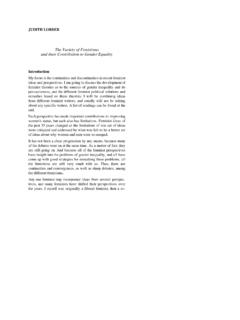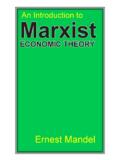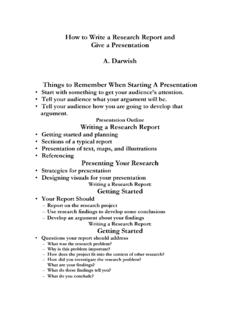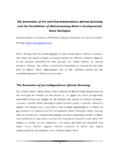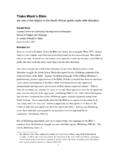Transcription of The Variety of Feminisms and their Contribution to …
1 JUDITH LORBERThe Variety of Feminismsand their Contribution to Gender EqualityIntroductionMy focus is the continuities and discontinuities in recent feministideas and perspectives. I am going to discuss the development offeminist theories as to the sources of gender inequality and itspervasiveness, and the different feminist political solutions andremedies based on these theories. I will be combining ideasfrom different feminist writers, and usually will not be talkingabout any specific writers. A list of readings can be found at perspective has made important contributions to improvingwomen's status, but each also has limitations. Feminist ideas ofthe past 35 years changed as the limitations of one set of ideaswere critiqued and addressed by what was felt to be a better setof ideas about why women and men were so has not been a clear progression by any means, because manyof the debates went on at the same time.
2 As a matter of fact, theyare still going on. And because all of the feminist perspectiveshave insight into the problems of gender inequality, and all havecome up with good strategies for remedying these problems, allthe Feminisms are still very much with us. Thus, there arecontinuities and convergences, as well as sharp debates, amongthe different one feminist may incorporate ideas from several perspec-tives, and many feminists have shifted their perspectives overthe years. I myself was originally a liberal feminist, then a so-JUDITH LORBER8cialist feminist, and now consider myself to be primarily a so-cial construction feminist, with overtones of postmodernism andqueer theory. Because I am not examining the ideas of particularfeminists but speaking of perspectives that have emerged frommany theorists, I will talk of Feminisms .
3 What I am looking atfirst, are feminist theories about why women and men areunequal, and second, feminist gender politics, the activities andstrategies for remedying gender reason for much of the change in feminist theories is thatwith deeper probing into the pervasiveness of gender inequality,feminists have developed more complex views about gender,sex, and sexuality. Gender is now understood to be a socialstatus, a personal identity, and a set of relationships betweenwomen and men, and among women and men. Sex is no longerseen as a one-way input or basic material for social arrange-ments, but a complex interplay of genes, hormones, physiology,environment, and behavior, with loop-back effects. Sexuality isunderstood to be socially constructed as well as physiologicallybased and emotionally main point feminists have stressed about gender inequalityis that it is not an individual matter, but is deeply ingrained inthe structure of societies.
4 Gender inequality is built into theorganization of marriage and families, work and the economy,politics, religions, the arts and other cultural productions, andthe very language we speak. Making women and men equal,therefore, necessitates social and not individual solutions. I havegrouped the feminist perspectives of the last 35 years into threebroad categories that reflect their theories and politicalstrategies with regard to the gendered social order. These aregender reform Feminisms , gender resistant Feminisms , andgender revolution Variety OF Feminisms ..9 Gender Reform FeminismsThe Feminisms of the 1960s and 1970s were the beginning of thesecond wave of feminism . They are liberal feminism , marxistand socialist Feminisms , and development feminism .
5 their rootswere, respectively, 18th and 19th century liberal politicalphilosophy that developed the idea of individual rights, Marx's19th century critique of capitalism and his concept of classconsciousness, and 20th century anti-colonial politics and ideasof national development. Gender reform Feminisms put womeninto these FeminismTheoretically, liberal feminism claims that gender differencesare not based in biology, and therefore that women and men arenot all that different -- their common humanity supersedes theirprocreative differentiation. If women and men are not different,then they should not be treated differently under the law. Womenshould have the same rights as men and the same educational andwork opportunities.
6 The goal of liberal feminism in the UnitedStates was embodies in the Equal Rights Amendment to the , which was never ratified. (It said, "Equality ofrights under the law shall not be denied or abridged by theUnited States or any state on account of sex.") Politically,liberal feminists formed somewhat bureaucratic organizations,which invited men members. their activist focus has beenconcerned with visible sources of gender discrimination, suchas gendered job markets and inequitable wage scales, and withgetting women into positions of authority in the professions,government, and cultural institutions. Liberal feminist politicstook important weapons of the civil rights movement -- anti-discrimination legislation and affirmative action -- and usedthem to fight gender inequality, especially in the job action calls for aggressively seeking out qualifiedpeople to redress the gender and ethnic imbalance in work-JUDITH LORBER10places.
7 That means encouraging men to train for such jobs asnursing, teaching, and secretary, and women for fields like engi-neering, construction, and police work. With a diverse pool ofqualified applicants, employers can be legally mandated to hireenough different workers to achieve a reasonable balance intheir workforce, and to pay them the same and also give an equalchance to advance in their main Contribution of liberal feminism is showing how muchmodern society discriminates against women. In the UnitedStates, it was successful in breaking down many barriers towomen's entry into formerly male-dominated jobs andprofessions, helped to equalize wage scales, and got abortionand other reproductive rights legalized.
8 But liberal feminismcould not overcome the prevailing belief that women and menare intrinsically different. It was somewhat more successful inproving that even if women are different from men, they are and Socialist FeminismsMarx's analysis of the social structure of capitalism was suppo-sed to apply to people of any social characteristics. If youowned the means of production, you were a member of the capi-talist class; if you sold your labor for a wage, you were amember of the proletariat. That would be true of women as well,except that until the end of the 19th century, married women incapitalist countries were not allowed to own property in theirown name; their profits from any businesses they ran and theirwages belonged to their husband.
9 Although Marx recognized thatworkers and capitalists had wives who worked in the home andtook care of the children, he had no place for housewives in hisanalysis of was marxist feminism that put housewives into the structure ofcapitalism. Housewives are vital to capitalism, indeed to anyindustrial economy, because their unpaid work in the homeTHE Variety OF Feminisms ..11maintains bosses and workers and reproduces the next gene-ration of bosses and workers (and their future wives). Further-more, if a bourgeois husband falls on hard times, his wife can dogenteel work in the home, such as dressmaking, to earn extramoney, or take a temporary or part-time job, usually white-collar. And when a worker's wages fall below the level neededto feed his family, as it often does, his wife can go out to workfor wages in factories or shops or other people's homes, or turnthe home into a small factory and put everyone, sometimesincluding the children, to work.
10 The housewife's labor, paid andunpaid, is for her and socialist Feminisms severely criticize the family asa source of women's oppression and exploitation. If a womanworks for her family in the home, she has to be supported, andso she is economically dependent on the "man of the house," likeher children. If she works outside the home, she is still expectedto fulfill her domestic duties, and so she ends up working twiceas hard as a man, and usually for a lot less source of gender inequality has been somewhat redressedin countries that give all mothers paid leave before and after thebirth of a child and that provide affordable child care. But thatsolution puts the burden of children totally on the mother, andencourages men to opt out of family responsibilities counteract that trend, feminists in the government of Norwayallocated a certain portion of paid child care leave to in the former communist countries had what liberalfeminism in capitalist economies always wanted for women --full-time jobs with state-supported maternity leave and child-care services.
